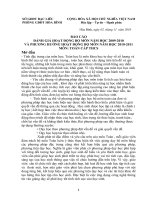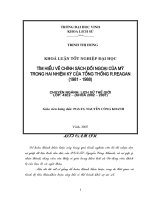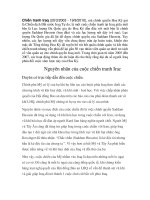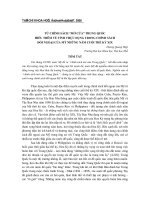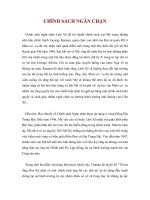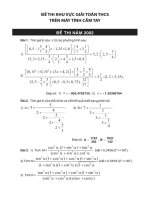comparing quantities grade 6 Bộ Sách Toán THCS Của Mỹ
Bạn đang xem bản rút gọn của tài liệu. Xem và tải ngay bản đầy đủ của tài liệu tại đây (3.81 MB, 55 trang )
Comparing
Quantities
Algebra
CuuDuongThanCong.com
/>
Mathematics in Context is a comprehensive curriculum for the middle grades.
It was developed in 1991 through 1997 in collaboration with the Wisconsin Center
for Education Research, School of Education, University of Wisconsin-Madison and
the Freudenthal Institute at the University of Utrecht, The Netherlands, with the
support of the National Science Foundation Grant No. 9054928.
The revision of the curriculum was carried out in 2003 through 2005, with the
support of the National Science Foundation Grant No. ESI 0137414.
National Science Foundation
Opinions expressed are those of the authors
and not necessarily those of the Foundation.
Kindt, M., Abels, M., Dekker, T., Meyer, M. R., Pligge M. A., & Burrill, G. (2006).
Comparing Quantities. In Wisconsin Center for Education Research & Freudenthal
Institute (Eds.), Mathematics in Context. Chicago: Encyclopædia Britannica, Inc.
Copyright © 2006 Encyclopædia Britannica, Inc.
All rights reserved.
Printed in the United States of America.
This work is protected under current U.S. copyright laws, and the performance,
display, and other applicable uses of it are governed by those laws. Any uses not
in conformity with the U.S. copyright statute are prohibited without our express
written permission, including but not limited to duplication, adaptation, and
transmission by television or other devices or processes. For more information
regarding a license, write Encyclopædia Britannica, Inc., 331 North LaSalle Street,
Chicago, Illinois 60610.
ISBN 0-03039627-1
1 2 3 4 5 6 073 09 08 07 06 05
CuuDuongThanCong.com
/>
The Mathematics in Context Development Team
Development 1991–1997
The initial version of Comparing Quantities was developed by Martin Kindt and Mieke Abels. It was
adapted for use in American schools by Margaret R. Meyer, and Margaret A. Pligge.
Wisconsin Center for Education
Freudenthal Institute Staff
Research Staff
Thomas A. Romberg
Joan Daniels Pedro
Jan de Lange
Director
Assistant to the Director
Director
Gail Burrill
Margaret R. Meyer
Els Feijs
Martin van Reeuwijk
Coordinator
Coordinator
Coordinator
Coordinator
Sherian Foster
James A, Middleton
Jasmina Milinkovic
Margaret A. Pligge
Mary C. Shafer
Julia A. Shew
Aaron N. Simon
Marvin Smith
Stephanie Z. Smith
Mary S. Spence
Mieke Abels
Nina Boswinkel
Frans van Galen
Koeno Gravemeijer
Marja van den
Heuvel-Panhuizen
Jan Auke de Jong
Vincent Jonker
Ronald Keijzer
Martin Kindt
Jansie Niehaus
Nanda Querelle
Anton Roodhardt
Leen Streefland
Adri Treffers
Monica Wijers
Astrid de Wild
Project Staff
Jonathan Brendefur
Laura Brinker
James Browne
Jack Burrill
Rose Byrd
Peter Christiansen
Barbara Clarke
Doug Clarke
Beth R. Cole
Fae Dremock
Mary Ann Fix
Revision 2003–2005
The revised version of Comparing Quantities was developed by Mieke Abels and Truus Dekker.
It was adapted for use in American schools by Gail Burrill.
Wisconsin Center for Education
Freudenthal Institute Staff
Research Staff
Thomas A. Romberg
David C. Webb
Jan de Lange
Truus Dekker
Director
Coordinator
Director
Coordinator
Gail Burrill
Margaret A. Pligge
Mieke Abels
Monica Wijers
Editorial Coordinator
Editorial Coordinator
Content Coordinator
Content Coordinator
Margaret R. Meyer
Anne Park
Bryna Rappaport
Kathleen A. Steele
Ana C. Stephens
Candace Ulmer
Jill Vettrus
Arthur Bakker
Peter Boon
Els Feijs
Dédé de Haan
Martin Kindt
Nathalie Kuijpers
Huub Nilwik
Sonia Palha
Nanda Querelle
Martin van Reeuwijk
Project Staff
Sarah Ailts
Beth R. Cole
Erin Hazlett
Teri Hedges
Karen Hoiberg
Carrie Johnson
Jean Krusi
Elaine McGrath
CuuDuongThanCong.com
/>
(c) 2006 Encyclopædia Britannica, Inc. Mathematics in Context
and the Mathematics in Context Logo are registered trademarks
of Encyclopædia Britannica, Inc.
Cover photo credits: (left to right) © PhotoDisc/Getty Images;
© Corbis; © Getty Images
Illustrations
1 Holly Cooper-Olds; 2 (top), 3 © Encyclopædia Britannica, Inc.;
23, 29 (left) Holly Cooper-Olds
Photographs
4 (counter clockwise) PhotoDisc/Getty Images; © Stockbyte;
© Ingram Publishing; © Corbis; © PhotoDisc/Getty Images;
6, 7 Victoria Smith/HRW; 10 Sam Dudgeon/HRW Photo;
16 © Corbis; 21 © Stockbyte/HRW; 23 PhotoDisc/Getty Images;
25 (left column top to bottom) © Corbis; PhotoDisc/Getty Images;
© Corbis; 28 Victoria Smith/HRW; 30 PhotoDisc/Getty Images
CuuDuongThanCong.com
/>
Contents
Letter to the Student
Section A
Section B
Section C
Section D
Section E
Compare and Exchange
Bartering
Farmer’s Market
Thirst Quencher
Tug-of-War
Summary
Check Your Work
vi
1
2
2
3
4
4
Looking at Combinations
The School Store
Workroom Cabinets
Puzzles
Summary
Check Your Work
6
10
13
14
14
Finding Prices
Price Combinations
Summary
Check Your Work
16
20
20
$50.00
Notebook Notation
Chickens
Mario’s Restaurant
Chickens Revisited
Sandwich World
Summary
Check Your Work
22
23
24
25
26
26
Equations
The School Store Revisited
Hats and Sunglasses
Return to Mario’s
Tickets
Summary
Check Your Work
28
29
30
31
32
32
ORDER TACO SALAD DRINK TOTAL
1
2
3
Additional Practice
34
Answers to Check Your Work
39
1
2
—
—
1
4
2
4
4
$ 3.00
$ 8.00
$ 11.00
4
5
6
7
Contents v
CuuDuongThanCong.com
/>
Dear Student,
Welcome to Comparing Quantities.
In this unit, you will compare quantities such as prices, weights,
and widths.
You will learn about trading and
exchanging things in order to
develop strategies to solve
problems involving combinations
of items and prices.
$50.00
$50.00
Combination charts and the notebook notation will help you
find solutions.
Combination Chart
Number of Pencils
3
ORDER TACO SALAD DRINK TOTAL
1
2
55
2
3
1
0
15
40
0
1
—
1
4
2
4
4
$ 3.00
$ 8.00
$ 11.00
4
65
5
6
25
0
1
2
—
7
2
3
Number of Erasers
In the end, you will have learned important ideas about algebra and
several new ways to solve problems. You will see how pictures can
help you think about a problem, how to use number patterns, and
will develop some general ways to solve what are called “systems
of equations” in math.
Sincerely,
The Mathematics in Context Development Team
vi Comparing Quantities
CuuDuongThanCong.com
/>
A
Compare and Exchange
Bartering
A long time ago money did not exist. People lived in small
communities, grew their own crops, and raised animals such as
cattle and sheep. What did they do if they needed something they
didn’t produce themselves? They traded something they produced
for the things their neighbors produced. This method of exchange
is called bartering.
Paulo lives with his family
in a small village. His family
needs corn. He is going to
the market with two sheep
and one goat to barter, or
exchange, them for bags
of corn.
First he meets Aaron, who says, “I only trade salt for
chickens. I will give you one bag of salt for every two
chickens.”
“But I don’t have any chickens,” thinks Paulo, “so I
can’t trade with Aaron.”
Later he meets Sarkis, who tells him, “I will give you
two bags of corn for three bags of salt.”
Paulo thinks, “That doesn’t help me either.”
Then he meets Ranee. She
will trade six chickens for a
goat, and she says, “My
sister, Nina, is willing to
give you six bags of salt for
every sheep you have.”
Paulo is getting confused. His family wants him to go home with bags
of corn, not with goats or sheep or chickens or salt.
1. Show what Paulo can do.
Section A: Compare and Exchange 1
CuuDuongThanCong.com
/>
A Compare and Exchange
Farmer’s Market
2. How many bananas do you need to balance the third scale?
Explain your reasoning.
10 bananas
2 pineapples
1 pineapple
2 bananas
1 apple
1 apple
3. How many carrots do you need to balance the third scale?
Explain your reasoning.
6 carrots
1 ear of corn
1 pepper
1 ear of corn
2 peppers
1 pepper
Thirst Quencher
4. How many cups of liquid can
you pour from one big bottle?
Explain your reasoning.
6 ؋
؍
؍
4 ؋
2 Comparing Quantities
CuuDuongThanCong.com
/>
؍
Compare and Exchange A
Tug-of-War
Four oxen are as strong as five horses.
An elephant is as strong as one ox and two horses.
5. Which animals will win the tug-of-war below? Give a reason for
your prediction.
Section A: Compare and Exchange 3
CuuDuongThanCong.com
/>
A Compare and Exchange
These problems could be solved using fair exchange. In this section,
problems were given in words and pictures. You used words, pictures,
and symbols to explain your work.
Delia lives in a community where people trade goods they produce
for other things they need. Delia has some fish that she caught, and
she wants to trade them for other food. She hears that she can trade
fish for melons, but she wants more than just melons. So she decides
to see what else is available.
This is what she hears:
•
•
•
•
For five fish, you can get two melons.
For four apples, you can get one loaf of bread.
For one melon, you can get one ear of corn and two apples.
For 10 apples, you can get four melons.
4 Comparing Quantities
CuuDuongThanCong.com
/>
1. Rewrite or draw pictures to represent the information so that it is
easier to use.
2. Use the information to write two more statements about
exchanging apples, melons, corn, fish, and bread.
3. Delia says, “I can trade 10 fish for 10 apples.” Is this true? Explain.
4. Can Delia trade three fish for one loaf of bread? Explain why or
why not.
5. Explain how Delia can trade her fish for ears of corn.
Explain how to use exchanging to solve a problem.
Section A: Compare and Exchange 5
CuuDuongThanCong.com
/>
B
Looking at Combinations
The School Store
Monica and Martin are responsible for
the school store. The store is open all
day for students to buy supplies.
Unfortunately, Monica and Martin can’t
be in the store all day to take students’
money, so they use an honor system.
Pencils and erasers are available for
students to purchase on the honor
system. Students leave exact change
in a small locked box to pay for their
purchases. Erasers cost 25¢ each, and
pencils cost 15¢ each.
1. One day Monica and Martin find
$1.10 in the locked box. How many
pencils and how many erasers
have been purchased?
2. On another day there is $1.50 in
the locked box. Monica and Martin
cannot decide what has been
purchased. Why?
3. Find another amount of money
that would make it impossible to
know what has been purchased.
6 Comparing Quantities
CuuDuongThanCong.com
/>
Looking at Combinations B
Monica wants to make finding the total price of pencils and erasers
easier, so she makes two price lists: one for different numbers of
erasers and one for different numbers of pencils.
4. Copy and complete the price lists for the erasers and the pencils.
Erasers
Price
Pencils
Price
0
$0.00
0
$0.00
1
$0.25
1
$0.15
2
$0.50
2
$0.30
3
$0.75
3
4
$1.00
4
5
$1.25
5
6
6
7
7
One day the box has $1.05 in it.
5. Show how Monica can use her lists
to determine how many pencils
and erasers have been bought.
Monica and Martin aren’t satisfied.
Although they now have these two
lists, they still have to do many
calculations. They are trying to think
of a way to get all the prices for all the
combinations of pencils and erasers
in one chart.
6. Reflect What suggestions can you
make for combining the two lists?
Discuss your ideas with your class.
Section B: Looking at Combinations 7
CuuDuongThanCong.com
/>
B Looking at Combinations
Monica and Martin come up with the
idea of a combination chart. Here you
see part of their chart.
b. How many combinations of
erasers and pencils can
Monica and Martin show
in this chart?
Number of Pencils
7. a. What does the 40 in the chart
represent?
Combination Chart
3
2
1
15 40
0
0 25
0
If you extend this chart, as shown
below, you can show more
combinations.
1
2
3
Number of Erasers
Use the combination chart on Student Activity Sheet 1 to solve the
following problems.
Number of Pencils
Costs of Combinations (in cents)
3
2
1
0
15 40
0 25
0
1
2
3
Number of Erasers
8. Fill in the white squares with the prices of the combinations.
9. Circle the price of two erasers and three pencils.
8 Comparing Quantities
CuuDuongThanCong.com
/>
Looking at Combinations B
Use the number patterns in your completed combination chart on
Student Activity Sheet 1 to answer problems 10–16.
10. a. Where do you find the answer to problem 1 ($1.10) in the
chart?
11. a. Reflect What happens to the numbers in
the chart as you move along one
of the arrows shown in the diagram?
b. Reflect Does the answer vary according
to which arrow you choose? Explain
your reasoning.
Number of Pencils
b. How many erasers and how many pencils can be bought
for $1.10?
Number of Erasers
12. What does moving along an arrow mean in terms of the numbers
of pencils and erasers purchased?
13. a. Mark on your chart a move from one square to another that
represents the exchange of one pencil for one eraser.
b. How much does the price change from one square to another?
14. a. Mark on your chart a move from one square to another that
represents the exchange of one eraser for two pencils.
b. How much does the price change for this move?
15. Describe the move shown in charts a and b below in terms of the
exchange of erasers and pencils.
b
Number of Pencils
Number of Pencils
a
Number of Erasers
Number of Erasers
16. There are many other moves and patterns in the chart. Find at
least two other patterns. Use different color pencils to mark
them on your chart. Describe each pattern you find.
Section B: Looking at Combinations 9
CuuDuongThanCong.com
/>
B Looking at Combinations
Workroom Cabinets
Anna and Dale are going to remodel a workroom. They want to put
new cabinets along one wall of the room. They start by measuring
the room and drawing this diagram.
315 cm
Window
330 cm
Door
Anna and Dale find out that the cabinets come in two different widths:
45 centimeters (cm) and 60 cm.
17. How many of each cabinet do Anna and Dale need in order for
the cabinets to fit exactly along the wall that measures 315 cm?
Try to find more than one possibility.
45 cm
60 cm
10 Comparing Quantities
CuuDuongThanCong.com
/>
Looking at Combinations B
330 cm
Anna and Dale wonder how they can design cabinets
for the longer wall.
315 cm
Window
The cabinet store has a convenient chart. The chart
makes it easy to find out how many 60-cm and 45-cm
cabinets are needed for different wall lengths.
18. Explain how Anna and Dale can use the chart to
find the number of cabinets they need for the
longer wall in the workroom.
Door
Lengths of Combinations (in cm)
11 495 555
10 450 510 570
Number of Short Cabinets
9 405 465 525 585
8 360 420 480 540
7 315 375 435 495 555
6 270 330 390 450 510 570
5 225 285 345 405 465 525 585
4 180 240 300 360 420 480 540
3 135 195 255 315 375 435 495 555
2 90 150 210 270 330 390 450 510 570
1 45 105 165 225 285 345 405 465 525
0
0
60 120 180 240 300 360 420 480
0
1
2
3
4
5
6
7
8
Number of Long Cabinets
Section B: Looking at Combinations 11
CuuDuongThanCong.com
/>
B Looking at Combinations
19. Can the cabinet store provide
cabinets to fit a wall that is
exactly 4 meters (m) long?
Explain your answer.
Wall
If cabinets don’t fit exactly, the
cabinet store sells a strip to fill
the gap. Most customers want
the strip to be as small as possible.
20. What size strip is necessary
for cabinets along a 4-m wall?
Strip
The chart has been completed to only 585 cm because longer rows of
cabinets are not purchased often. However, one day an order comes
in for cabinets to fit a wall exactly 6 m long. One possible way to fill
this order is 10 cabinets of 60 cm each.
21. Reflect What are other possibilities for a cabinet arrangement
that will fit a 6-m wall? Note that although you do not see 600 in
the chart, you can still use the chart to find the answer. How?
On the left is a part of the cabinet
combination chart.
Lengths of Combinations (in cm)
7 315 375 435 495 555
22. What is special about the
move shown by the arrow?
Number of Short Cabinets
6 270 330 390 450 510 570
23. If you start in another square
in this chart and you make
the same move, what do you
notice? How can you explain
this?
5 225 285 345 405 465 525 585
4 180 240 300 360 420 480 540
3 135 195 255 315 375 435 495 555
2
90
150 210 270 330 390 450 510
1
45
105 165 225 285 345 405 465
0
0
60
0
1
120 180 240 300 360 420
2
3
4
5
6
7
Number of Long Cabinets
12 Comparing Quantities
CuuDuongThanCong.com
/>
Looking at Combinations B
Puzzles
24. Complete the puzzles on Student Activity Sheet 2.
a
b
37
27
18
0
0
5
c
d
20
35
55
24
0
0
Section B: Looking at Combinations 13
CuuDuongThanCong.com
/>
B Looking at Combinations
A combination chart can help you
compare quantities. A combination
chart gives a quick view of many
combinations.
Charts can be used to solve
many problems, as you studied
in “The School Store” and
“Workroom Cabinets.” In this chart
the arrow represents the exchange
of one pencil for one eraser.
Number of
Whirlybird Rides
Numbers of Tickets
8
7
6
5
4
3
2
1
0
6
4 9
2 7 12
0 5 10 15
0 1 2 3 4 5 6 7 8 9 10
3
Number of Pencils
Discovering patterns within
combination charts can make
your work easier by allowing
you to discover patterns and
extend the chart in any direction.
Combination Chart
2
55
1
15
40
0
0
25
0
1
65
2
Number of Erasers
This year the school fair has
two rides. The Loop-D-Loop
costs five tickets, and the
Whirlybird costs two tickets.
1. In your notebook, copy the
combination chart that
shows how many tickets
are needed for different
combinations of these two
rides. Complete the chart
as necessary to solve the
word problems.
Number of
Loop-D-Loop Rides
14 Comparing Quantities
CuuDuongThanCong.com
3
/>
2. How many tickets are needed for two rides on the Loop-D-Loop
and three rides on the Whirlybird?
3. Janus has 19 tickets. How can she use these tickets for both rides
so that she has no leftover tickets?
4. a. On your combination chart, mark a move from one square
to another that represents the exchange of one ride on the
Whirlybird for two rides on the Loop-D-Loop.
b. How much does the number of tickets as described in 4a,
change as you move from one square to another?
5. Use the combination chart on
Student Activity Sheet 3.
a. Write a story problem that uses
the combination chart.
b. Label the bottom and left side
of your chart. Give the chart a
title and include the units.
c. What do the circled numbers
represent in your story problem?
50 52 54 56 58 60
40 42 44 46 48 50
30 32 34 36 38 40
20 22 24 26 28 30
10 12 14 16 18 20
0
2
4
6
8
10
Do you think combination charts will always have a horizontal and
vertical pattern? Why or why not? What about a pattern on the
diagonal?
Section B: Looking at Combinations 15
CuuDuongThanCong.com
/>
C
Finding Prices
Price Combinations
So far you have studied two strategies
for solving problems that involve
combinations of items. The first
strategy, exchanging, applied to the
problems about trading food at the
beginning of the unit. The second
strategy was to make a combination
chart and use number patterns found
in the chart.
In this section, you will apply the
strategy of exchanging to solve
problems involving the method
of fair exchange.
Use the drawings below to answer problems 1–3.
1. Without knowing the price of a pair of sunglasses
or a pair of shorts, can you determine which item
is more expensive? Explain.
2. How many pairs of shorts can you buy for $50?
3. What is the price of one pair of sunglasses? Explain your
reasoning.
$50.00
$50.00
16 Comparing Quantities
CuuDuongThanCong.com
/>
Finding Prices C
4. What is the price of one umbrella? One cap?
$80.00
$80.00
$76.00
Sean bought two T-shirts and one sweatshirt for a total of $30. When
he got home, he regretted his purchase. He decided to exchange one
T-shirt for an additional sweatshirt.
Sean made the exchange, but he had to pay $6 more because the
sweatshirt is more expensive than the T-shirt.
5. What is the price of each item? Explain your reasoning.
$8.00
$7.00
Josh spent $8 to buy
four clipboards and
eight pencils.
Denise spent $7 to buy
three clipboards and
10 pencils.
Denise wants to trade Josh two pencils for a clipboard.
6. Is the trade a fair exchange? If not, who has to pay the difference,
and how much is it?
7. What is the price of a pencil? What is the price of a clipboard?
Explain your reasoning.
Section C: Finding Prices 17
CuuDuongThanCong.com
/>
C Finding Prices
You can use a chart to solve some of these shopping problems.
This combination chart represents the problem of the caps and the
umbrellas (page 17).
8. Complete this chart on Student Activity Sheet 4. Then find the
prices of one cap and one umbrella. Is this the same answer you
found for problem 4 on page 17?
Costs of Combinations
(in dollars)
Number of Umbrellas
5
4
3
80
2
1
76
0
0
1
2
3
4
5
Number of Caps
9. Study the two pictures of sunglasses and shorts. Use one of the
extra charts on Student Activity Sheet 4 to make a combination
chart for these items. Label your chart. What is the price of one
pair of sunglasses? One pair of shorts?
$50.00
$50.00
At Doug’s Discount Store, all CDs are one price; all DVDs are
another price.
David buys three CDs and two DVDs for $67.
Joyce buys two CDs and four DVDs for $90.
10. What is the price of one CD? One DVD? You may use any strategy.
18 Comparing Quantities
CuuDuongThanCong.com
/>
Finding Prices C
On a visit to Quinn’s Quantities, Rashard finds the prices for various
combinations of peanuts and raisins.
•
A mixture of 3 cups of peanuts
and 2 cups of raisins costs $3.30.
•
A mixture of 4 cups of peanuts
and 3 cups of raisins costs $4.55.
11. What does Rashard pay for a mixture of 5 cups of peanuts and
2 cups of raisins? You may use any strategy.
12. Reflect Create your own shopping problem. Solve the problem
yourself, and then ask someone else to solve it. Have the person
explain to you how he or she found the solution.
In solving shopping problems, you have used exchanging and
combination charts. Joe studied the problem below and used a
different strategy.
Follow Joe’s strategy to see how he found the price of each candle.
13. Explain Joe’s reasoning.
Joe
$7.30
......................................
$1.70
..................
$5.10
......................................
$2.20
............................................
$1.10
............................................
$0.60
$3.40
Section C: Finding Prices 19
CuuDuongThanCong.com
/>

